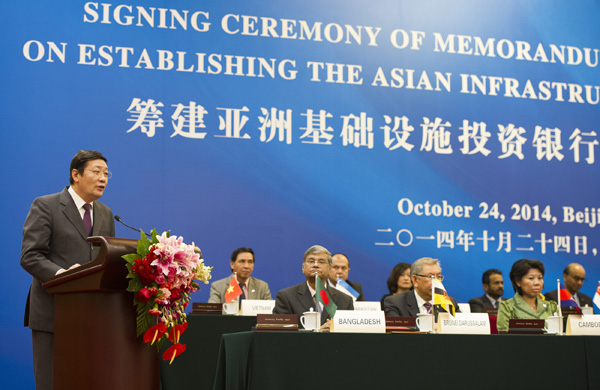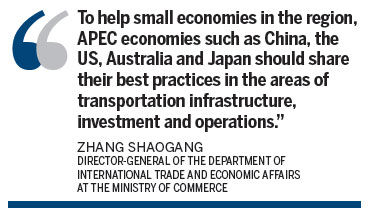 |
|
Finance Minister Lou Jiwei addresses members during the signing ceremony of the Asian Infrastructure Investment Bank at the Great Hall of the People in Beijing on Oct 24. The bank will develop regional business activity through better-developed transportation facilities. [Photo/Xinhua] |
Blueprint will cover hardware, software and people-to-people exchanges among its members
Asia-Pacific economies will count on enhanced regional connectivity to stimulate trade and attract investment as they pursue decisive measures to improve regional economic integration.
Assistant Minister of Commerce Wang Shouwen said that regional connectivity is among the 21 member economies' top priorities when it comes to promoting comprehensive development in infrastructure, investment, regional trade and tourism.
Wang said that China wants to speed up the formulation of the APEC Blueprint on Connectivity, which involves hardware, software and people-to-people exchanges to provide a strong foundation for the Asia-Pacific region's long-term development.

"The blueprint will be helpful in addressing the achievements and challenges to connectivity in this region, as well as key initiatives for enhanced APEC connectivity and strategies for implementation," said Wang.
Hardware (or physical connectivity) includes maritime, land and air transport, energy infrastructure, telecommunications and information and communication technology.
Software (or institutional connectivity) comprises customs, supply chains, finance, regulatory coherence and structural reform.
People-to-people connectivity includes business mobility, student and researcher mobility, tourism facilitation, labor and professional mobility and cross-border education.
Yu Ping, vice-chairman of the China Council for the Promotion of International Trade, said that the top priority is to establish a flexible physical transportation network throughout the Asia-Pacific region to further stimulate economic growth.
"The APEC economies, particularly those in Southeast Asia and South America, such as Vietnam, Indonesia, Peru and Chile, are building new platforms for broader cooperation with major APEC economies," said Yu.
These platforms include upgraded logistics services, giant international shipping companies, new air routes, pipelines, port facilities and land and sea telecommunications.
"From a long-term view, the new mechanism will fully support trade, private investment, industrial productivity and the service sector in the APEC region," said Phaichit Viboontanasarn, commercial minister at the Thailand Embassy in Beijing.
Chen Yingming, executive vice-president of the Shanghai-based China Port and Harbors Association, said that rail, road and sea connectivity projects between Singapore and Malaysia this year set an example for the development of similar routes among the APEC economies.
APEC leaders agreed in Singapore in 2009 to commit to enhancing transportation routes to promote regional connectivity.
And in addition to APEC members, 21 Asian countries - including Bangladesh, Brunei, Cambodia, China, India, Kazakhstan, Kuwait, Laos and Malaysia - signed a memorandum of understanding last month in Beijing to establish the Asian Infrastructure Investment Bank. The bank will develop regional business activity through better-developed transportation facilities.
|
 |
 |
| Chinese companies pitch in for APEC | AIIB good for region, good for the world |
